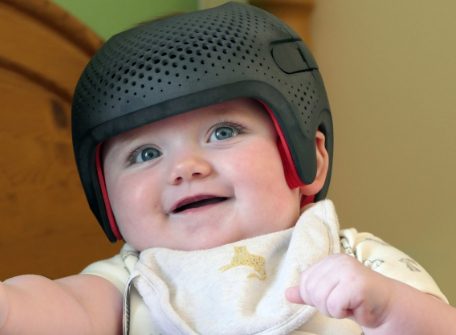Helmet therapy is basically a process of gradually improving and correcting the form of the skull of a baby. The skulls of newborns are soft plates with gaps between them. These plates grow alongside the baby, eventually hardening and knitting together.
When a baby sleeps in the same posture for an extended period of time, the soft plates may develop a flat patch or uneven appearance known as Plagiocephaly which is a common condition that poses no risk to your baby’s brain. Your paediatrician may recommend repositioning, exercises, or helmet therapy if the issue does not improve on its own.
What is Helmet Therapy?
Helmet therapy (also known as helmet orthosis) is a treatment that is used to help form a baby’s skull.
The skulls of babies are made up of several bone plates. Sutures, which look like fibres, connect the plates. Sutures aid in the protection of the baby’s brain within the skull. They also provide some freedom and space for the brain to develop.
Moulding helmets must be worn while the skull and brain are actively growing in order to work. Helmets are useless when brain growth is completed, and three-quarters of brain growth occurs by the age of two.
When Do Babies Need A Helmet Therapy?
- Deformational plagiocephaly, brachycephaly, and MICROcephaly are three conditions that alter the shape of a baby’s skull. They are caused by pressure on the skull when an infant is in one position for an extended period of time.
- Craniosynostosis is a condition that occurs when the bony plates of the skull become abnormally fused together. The shape of the head becomes abnormal as the brain pushes out on the other parts of the skull in a child with craniosynostosis as the brain grows. Brain growth may be affected in some cases as well. Craniosynostosis necessitates surgery and, in some cases, helmet therapy.
How To Know Whether Your Child Need A Helmet Therapy?
- If your child is less than 12 months old and has deformational plagiocephaly, brachycephaly, or scaphocephaly, cranial remoulding may be recommended to rectify the shape of the baby’s skull. Helmets can only be worn if they are prescribed by a competent physician. It’s crucial to remember that not all infants are ideal candidates for helmet therapy, so talk to your doctor about it.
- Furthermore, if your children have had an endoscopy to repair craniosynostosis, helmet therapy will be recommended after surgery to help them improve their skull shape even more.
How Does Helmet Therapy work?
A strong outer shell with a foam interior is typical of cranial remoulding helmets. Gentle, persistent pressures are used to capture a baby’s natural head growth while restricting growth in inconspicuous spots and permitting growth in flat areas.
As your baby’s head grows, adjustments are made on a regular basis. The helmet provides a compact, circular area for the head to grow into. Even if your child continues to sleep on one side, the helmet will cover the skull and keep it from flattening further.
How Long Will Your Baby Need Helmet Therapy?
Every child is unique. Much depends on the age of the child when he or she began helmet therapy. The brain and skull of a baby expand rapidly during infancy. This means the helmet can direct growth in a shorter amount of time.
At each appointment, the specialist will assess your child’s progress to see if the head shape is improving. For several months, children may need to wear a helmet. More time and a second helmet may be beneficial to some children.
Conclusion
Your infant will not experience any pain or discomfort as a result of helmet therapy. After examining your baby’s head form, a paediatrician may recommend a helmet. A recommendation to someone who is trained to measure and fit the helmet properly is required.
To discover more about head malformations in babies and whether the helmet therapy is right for your kid, contact our clinic Hope AMC in Dubai. To schedule an appointment, click here.


